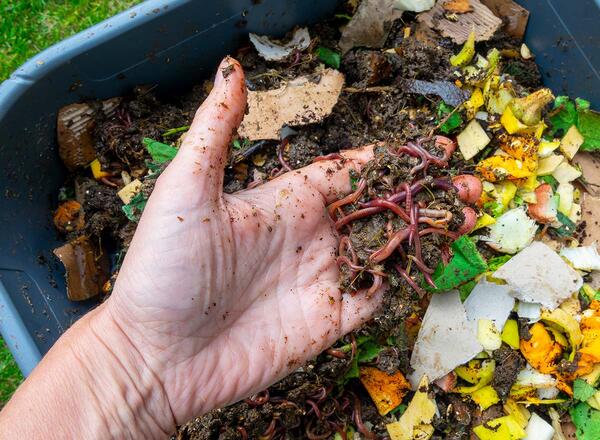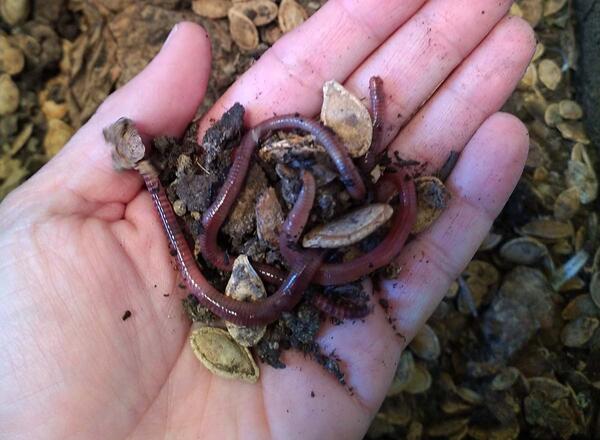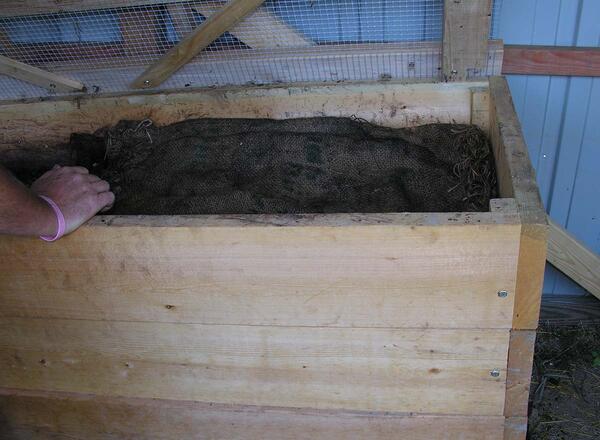Countless living things live in the soil, whose job is to break down material and turn it into organic matter. Most of these organisms we need a microscope to see such as fungus and bacteria. But there are also other larger animals we can see with our naked eye. We call this system the soil food web. And one animal part of this food web is the earthworm!
Worms may all look the same to us, but scientists have identified hundreds of different species around the world. These wiggly wonders play a role in breaking down leaves, sticks, dead animals, and more back into the soil.
Organic wastes, landfills, and our environment
We send a lot of waste to landfills. There are items we recycle like plastic bottles and paper. Yet some of the heaviest material that winds up in a landfill is food waste, yard waste, and other organic debris. In the landfill, this material begins to break down in massive piles without access to oxygen. Decomposition without oxygen is called anaerobic decomposition and creates smelly byproducts. One of those byproducts is methane, a combustible greenhouse gas that can be a problem for our landfills and environment. Keeping organic waste out of a landfill will help reduce greenhouse emissions and prolong the lifespan of our landfills. To aid in this endeavor, humans have harnessed the power of worms to help us keep food scraps out of landfills and recycle them back into organic matter.
When we are asked to describe an ocean, forest, desert, or even our backyard we can give a pretty clear description about what one might find there. When asked what is under the ground, we tend to be unsure and it becomes clear how little we know about what is below our own backyards. Worms come...

Using worms to break down organic wastes into compost is called vermicomposting. In Illinois, vermicomposting works best when the worms are in an enclosed container typically called a worm bin. The worm bin is where your worms will live and eat your food waste. Worm bins can be made at home out of a single plastic tote, while other worm bins can be purchased and may have a stacking system of trays. In the stacking tray system worms can move up and down in this bin. Once they turn one tray of food scraps into compost another can be added on top. As the worms move up to the new tray the bottom one can be harvested.

In the worms bin, we don’t use the type of worms you would find outside in Illinois soils. We use specialized worms from Central and South America called red wigglers (Eisenia foetida). These worms are surface dwellers, living on forest floors and eating organic material. Red Wigglers can eat more than half their body weight in one day! Because they eat so much and are good at scavenging, they make excellent worms for the worm bin.
Red wigglers will not survive our winters and therefore care must be taken to keep them from getting too cold or too hot. Keep the bin in locations that stay between 55 and 80 degrees Fahrenheit and avoid direct sunlight.
Red wigglers are typically sold by the pound or by the hundred. They can be purchased at many pet stores or ordered online. When ordering online, the company may not ship during the winter as this can kill the worms if they are exposed to freezing temperatures. Be sure you are buying red wigglers and avoid worm species that have shown to be a pest such as the invasive jumping worm.
The first thing we need is bedding. Because red wigglers live on the forest floor, we need to simulate what it would be like in their habitat. Bedding is like the leaves they would be crawling through and munching on. And for that, we use shredded newspaper. Avoid glossy paper or paper that feels ‘slick.’ Wet the bedding so that it has the moisture consistency of a wrung-out sponge. If you squeeze in your hand a few drops of water should still drip out.
Next, we need to give them a little grit because worms don’t have teeth. They have an organ called a crop (like a chicken) that mashes up their food. They eat sand and small pieces of gravel to help in that mashing process.
An optional step is to add a little bit of soil and organic matter from outside. Remember all the fungi and bacteria mentioned before? Worms don’t do this job alone. They need the help of their microscopic friends.
Finally, worms need water, but not too much water. Water is critical to helping them move. However, worms breathe through their skin, so too much moisture causes it so they cannot breathe and they can drown. That’s why after a lot of rain we see so many worms coming out of the ground. Because the soil is saturated or full of water the worms need to come up for air.

If you follow the above steps you are ready to introduce your worms to their new worm bin. But there is one important piece missing. Their food!
Red wigglers will eat pretty much anything. Crushed eggshells, uncooked vegetables like celery, or apple cores. They’ll eat pancakes (without the butter or syrup), old bread, and stale breakfast cereals. Particle size matters too. The smaller you can chop these things up, the easier it is for the worms to eat them. Softening vegetable scraps by putting them in the freezer for a few hours can help too.
Recommended worm food is raw vegetable scraps. A variety of materials works best.
- Fruits (banana peels, watermelon, apple cores, etc.)
- Vegetables (squash, pumpkin, tomatoes, etc.)
- Shredded paper (newspaper, egg cartons, etc.)
- Grit (crushed eggshells or sand)
- Coffee grounds – coffee is acidic. Too much can make a worm bin uninhabitable.
- Pasta (no sauce)
- Stale breads
- Tea Bags
- Dry leaves
Limit the amount of citrus like orange peels as this can create an acidic environment.
Strong-smelling foods like onion and broccoli may also create pungent odors. Burying food scraps under existing vermicompost and lots of moist bedding can limit odors or just don’t use this material.
Avoid meats, dairy, and foods cooked in oils and butter.
- Salty foods
- Spicy foods
- Oils and other fats
- Meat
- Dairy
- Anything glossy or with a plastic coating (i.e. the little stickers on most fruits)
- Dryer lint – Most of our clothes have at least some amount of plastic in them. Unless you make your clothes from natural fibers, your dryer lint is going to have lots of plastic fibers the worms can’t eat.